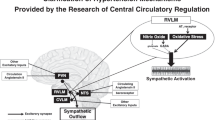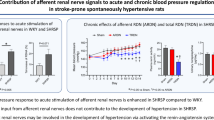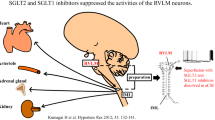Abstract
Brain ischemia is often accompanied by acute gastric lesions. To clarify the underlying mechanism, the influence of acute ischemic insult to the brain on gastric hemodynamics and mucosal integrity was examined in spontaneously hypertensive rats. One hour after brain ischemia, gastric mucosal blood flow decreased to 71% of the preischemic levels in the control rats but was preserved significantly better, at 94 and 108%, in the prazosin-treated and guanethidine-treated rats, respectively. Vagotomy almost abolished the decrease in gastric mucosal blood flow during cerebral ischemia. Intragastric 0.6 N hydrochloric acid administered just after reperfusion induced more severe hemorrhagic ulcers in the control than in the prazosin-treated and vagotomized groups. These results suggest that noradrenergic neurons acting through α1-adrenoceptors contributes to the decrease in gastric mucosal blood flow, and the subsequent disturbed integrity of the gastric mucosa, through the vagal adrenergic pathway during brain ischemia in spontaneously hypertensive rats.
Similar content being viewed by others
References
Kitamura T, Ito K: Acute gastric changes in patients with acute stroke. 1: With reference to gastroendoscopic findings. Stroke 7:460–463, 1976
Kitamura T, Ito K: Acute gastric changes in patients with acute stroke. 2: Gastroendoscopic findings and biochemical observation of urinary noradrenalin, adrenalin, 17-OHCS and serum gastrin. Stroke 7:464–468, 1976
Hunt D, Gore I: Myocardial lesions following experimental intracranial hemorrhage. Am Heart J 83:232–236, 1972
Myers MG, Norris JW, Hachinski VC, Sole MJ: Plasma norepinephrine in stroke. Stroke 12:200–204, 1981
Neil-Dwyer G, Walter P, Cruickshank JM, Doshi B, O'Gorman P: Effect of propranolol and phentolamine on myocardial necrosis after subarachnoid hemorrhage. Br Med J 2:990–992, 1978
Malik AB: Mechanisms of neurogenic pulmonary edema. Circ Res 57:1–18, 1985
Guth PH: Gastric blood flow in restraint stress. Am J Dig Dis 17:807–813, 1972
Kitagawa H, Fujiwara M, Osumi Y: Effects of water immersion stress on gastric secretion and mucosal blood flow in rats. Gastroenterology 77:298–302, 1979
Hayase M, Takeuchi K: Gastric acid secretion and lesion formation in rats under water-immersion stress. Dig Dis Sci 31:166–171, 1986
Murakami M, Lam SK, Inasa M, Miyake T: Pathophysiology and pathogenesis of acute gastric mucosal lesions after hypothermic restraint stress in rats. Gastroenterology 88:660–665, 1985
Ross IN, Bahari HMM, Turnberg LA: The pH gradient across mucus adherent to rat fundic mucosa in vivo and the effects of potential damaging agents. Gastroenterology 81:713–718, 1981
Somasundarum K, Ganguly AK: Gastric mucosal protection during restraint stress in rats. Alteration in gastric adherent mucus and dissolved mucus in gastric secretion. Hepatogastroenterology 32:24–26, 1985
Auguste LJ, Argus L, Stein TA, Wise L: Arachidonic acid protection of rat mucosa against stress ulceration. J Surg Res 43:103–106, 1987
Konturek PK, Brzozowski T, Konturek SJ, Dembinski A: Role of epidermal growth factor, prostaglandin and sulfhydryls in stress-induced gastric lesions. Gastroenterology 99:1607–1615, 1990
Fujishima M, Ishitsuka T, Nakatomi Y, Tamaki K, Omae T: Changes in local cerebral blood flow following bilateral carotid occlusion in spontaneously hypertensive and normotensive rats. Stroke 12:874–876, 1981
Eklöf B, Siesjö BK: Cerebral blood flow in ischemia caused by carotid artery ligation in the rat. Acta Physiol Scand 87:69–77, 1973.
Choki J, Yamaguchi T, Takeya Y, Morotomi Y, Omae T: Effect of carotid artery ligation on regional cerebral blood flow in normotensive and spontaneously hypertensive rats. Stroke 8:374–379, 1977
Ogata J, Fujishima M, Morotomi Y, Omae T: Cerebral infarction following bilateral carotid artery ligation in normotensive and spontaneously hypertensive rats. A pathological study. Stroke 7:54–60, 1976
Aukland K, Bower BF, Berliner RW: Measurement of local blood flow with hydrogen gas. Circ Res 14:164–187, 1964
Yao H, Sadoshima S, Shiokawa O, Fujii K, Fujishima M: Renal blood flow in acute cerebral ischemia in spontaneously hypertensive rats: Effects ofα- andβ-adrenergic blockade. Stroke 18:629–633, 1987
Salim AS: Stress, the adrenergic hypothalamovagal pathway, and chronic gastric ulceration. J Psychosom Res 31:85–90, 1987
Salim AS: Reserpine, vagal adrenergic activity and stress-induced acute gastric mucosal injury in the rat. J Physiol 392:363–376, 1987
Izumiyama K, Kogure K: Experimental analysis of gastric mucosal blood flow after transient forebrain ischemia. Res Exp Med 190:301–303, 1990
Boura AL, Green AF: Adrenergic neuron blocking agents. Annu Rev Pharmacol 5:183–212, 1965
Furst CI: The biochemistry of guanethidine. Adv Drug Res 4:133–161, 1967
Lundberg J, Ahlman H, Dahlström A, Kewenter J: Catecholamine-containing nerve fibres in the human abdominal vagus. Gastroenterology 60:81–84, 1971
Dhital K, Lincoln J, Appenzeller O, Burnstock G: Adrenergic innervation of vasa and nervi nervorum of optic, sciatic, vagus and sympathetic nerve trunks in normal and streptozotocin-diabetic rats. Brain Res 367:39–44, 1986
Guth PH, Leung FW: Physiology of the gastric circulation.In Physiology of the gastrointestinal tract, 2nd ed, LR Johnson, J Christensen, MJ Jachson, ED Jacobson, JH Walsh (eds). New York, Raven Press, 1986, pp 1031–1053
Author information
Authors and Affiliations
Rights and permissions
About this article
Cite this article
Kawakubo, K., Ibayashi, S., Nagao, T. et al. Brain ischemia and gastric mucosal damage in spontaneously hypertensive rats. Digest Dis Sci 41, 2383–2391 (1996). https://doi.org/10.1007/BF02100132
Received:
Revised:
Accepted:
Issue Date:
DOI: https://doi.org/10.1007/BF02100132




